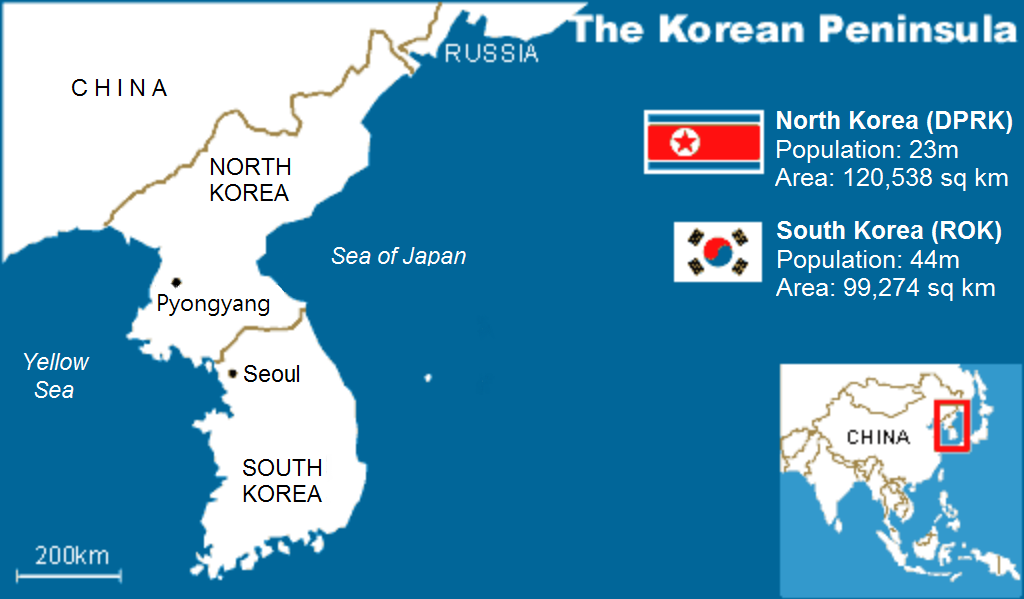
The situation on the Korean Peninsula has remained tense since the beginning of 2017.
The dangerous state of affairs on the peninsula involves China’s own security and development. Its roots lie in North Korea’s nuclear program. The tensions can’t be fundamentally dissolved, peace and stability in Northeast Asia can’t be preserved until Pyongyang forsakes its nuclear pursuit. In the early 1990s, China and the US worked together to make it possible for North and South Korea to simultaneously join the United Nations. On the basis of the DPRK and ROK recognizing each other’s sovereignty, China and the ROK normalized relations in 1993. The US, rather than seeking to normalize ties with the DPRK as anticipated, continued to exert pressure on the latter. As for the two countries that had previously provided security guarantees for Pyongyang, the Soviet Union collapsed, and China has joined the US-led world order through reform and opening up.
North Korea began to develop nuclear weapons in 1994, in a bid to provide strategic deterrence for national security, at least to offer a powerful bargaining chip. In Pyongyang’s eyes, the key to its security is in the hand of Americans. Therefore the only request it has adhered to since launching its nuclear program is to hold direct dialogue with Washington, and hence normalize bilateral relations. During the Obama presidency, the US had completed its global nuclear materials (transport) monitoring regime, thus had sufficient confidence in blocking the outflow of nuclear materials from North Korea. So Washington displayed fresh strategic thinking regarding the DPRK nuclear issue. The Obama administration observed that North Korea’s nuclear pursuit exposed China’s strategic dilemma. On one hand, given its special relations with Pyongyang and the latter’s critical role in China’s security environment, Beijing had no alternative but to “persuade” the DPRK to forsake its nuclear pursuit. On the other hand, for its own “peaceful development”, China must preserve stable China-US relations, and therefore wouldn’t make enemies again with the US and ROK because of Pyongyang. For North Korea, this meant it couldn’t count on China to provide a fundamental security guarantee. It was precisely that Chinese strategic dilemma that has allowed Pyongyang to become increasingly reckless down the road of nuclear adventure in total disregard of Chinese security interests.
Meanwhile, both Japan and South Korea tended to distance themselves from the US when Obama was elected. After assuming national leadership in 2009, Japan’s Democratic Party openly proposed to not extend the agreement on the US military base in Okinawa. Under such a circumstance, pressing hard to resolve the DPRK nuclear issue may not only further deplete US strategic resources in the Asia-Pacific, but also weaken US control over Japan and South Korea. The US has found a stronger need for closer security alliance with Japan and South Korea since Obama put forward the strategy of “rebalancing” to the Asia-Pacific in 2010.
In an obvious break from the proactive postures of his two immediate predecessors on the Korea nuclear issue, Obama adopted a policy of continuing to exert pressures, yet refraining from rushing to a resolution. On one hand, Washington ignored North Korea’s calls for dialogue, dragged its feet on various China-proposed resolutions, and “froze” six-party talks; on the other hand, it sustained high pressures on North Korea, constantly escalating US-ROK military exercises with North Korea as the imaginary enemy, and imposing economic sanctions at the same time. The aim was to press North Korea into the corner, and make it attack in desperation. The outcome has been the vicious circle of “sanction – nuclear test – new sanction – new nuclear test” since 2009.
The fundamental US goal in doing this was to turn the DPRK nuclear issue into a Chinese strategic weakness, so that it can exploit it and contain China, killing two birds with one stone.
First, the US took advantage of China’s strategic dilemma that it was neither capable of persuading North Korea to abandon its nuclear program, nor willing to take sides with the US, Japan and South Korea to suppress Pyongyang — creating the impression in the international community that only China could prevent North Korea from developing nuclear weapons, but it is unwilling to do so. By shifting responsibilities for the DPRK nuclear issue onto China and making it a “Chinese problem”, the US attempted to deprive China of its moral high ground, and take advantage of the vicious circle over the nuclear issue to exhaust Chinese strategic resources.
Second, escalating tensions over the DPRK’s nuclear program not only helped the US to tighten its grip on Japan and South Korea strategically, but also offered it a forceful excuse for deploying THAAD in South Korea. In fact, as China upgrades it long-range strike forces and Russia deploys more forces for strategic strike in the Far East, the US will have to incorporate the area into its global missile defense system. By deploying THAAD in South Korea, the US can monitor both China and Russia, tilting regional strategic balance in its favor.
The Obama administration’s strategy obvious worked. On one hand, China-DPRK relations keep deteriorating. There has not been a summit meeting since Xi Jinping and Kim Jong-un assumed office, which is unprecedented in bilateral ties, demonstrating rare embarrassment and tension. On the other hand, with THAAD being deployed, China-ROK relations have dropped to a nadir since diplomatic relations were established in 1992. More seriously, China’s awkward position on the DPRK nuclear issue has begun to show negative impacts on Chinese diplomacy and the Belt and Road Initiative.
China must reconsider its approach to the DPRK nuclear issue, make decisive moves and reverse its passive strategic position. During his phone conversation with Donald Trump, Xi put forward three principles for resolving the DPRK nuclear issue:
1. It must be handled in accordance with UN resolutions;
2. All parties should exert restraint, so as to prevent conditions from worsening;
3. All parties concerned should make concerted efforts and solve the issue via negotiations.
Under these principles, China should unequivocally present its own proposals, and play a proactive role.
It must be made clear that “North Korea abandoning nuclear weapons” is an unshakeable principle of China’s; Beijing should also clarify that “friendly cooperation” is the basis and premise of the China-Korea Treaty on Friendly Cooperation and Mutual Assistance. Since North Korea has single-mindedly gone its own way in developing nuclear weapons, disregarding significant Chinese interests and concerns, it is neither friendly, nor cooperative, and has completely destroyed the basis for “mutual assistance”. Only when North Korea forsakes nuclear weapons can China fulfill its responsibilities for the DPRK’s national security as stipulated in the treaty, and actively help the latter with its modernization drive, including modernizing its defense technologies.
In both theory and practice, stability of the Kim regime must be distinguished from that of North Korea as a country. The Kim administration’s reckless, extremist deeds in the pursuit of nuclear capacity have not only endangered the peace and development on the peninsula and the Asia-Pacific, but have severely damaged North Korea’s own national security and people’s livelihoods. As a friendly, responsible neighbor of North Korea’s, China must assume due responsibilities for peace on the peninsula as well as the well-being of the 25 million North Koreans. But that does not mean China is under any obligation to safeguard the Kim regime.
Together with the US, Russia, Japan and South Korea, China will faithfully implement UN resolutions. In the meantime, it will press the Kim regime to abandon its nuclear program through active negotiation, and make it aware that forsaking nuclear weapons is the only way out, or it faces the risk of losing power.
Finally, China should also openly state that it will definitely not allow a war in North Korea, not to mention looking on while North Korea becomes Northeast Asia’s “Middle East”.
Starting a war will absolutely not solve the problem. Instead, it will be the beginning of turbulence. With the ability and resolve of present-day China, no matter who triggers a war, China will prove the only country capable of controlling the situation and rebuilding order in a post-war North Korea.




